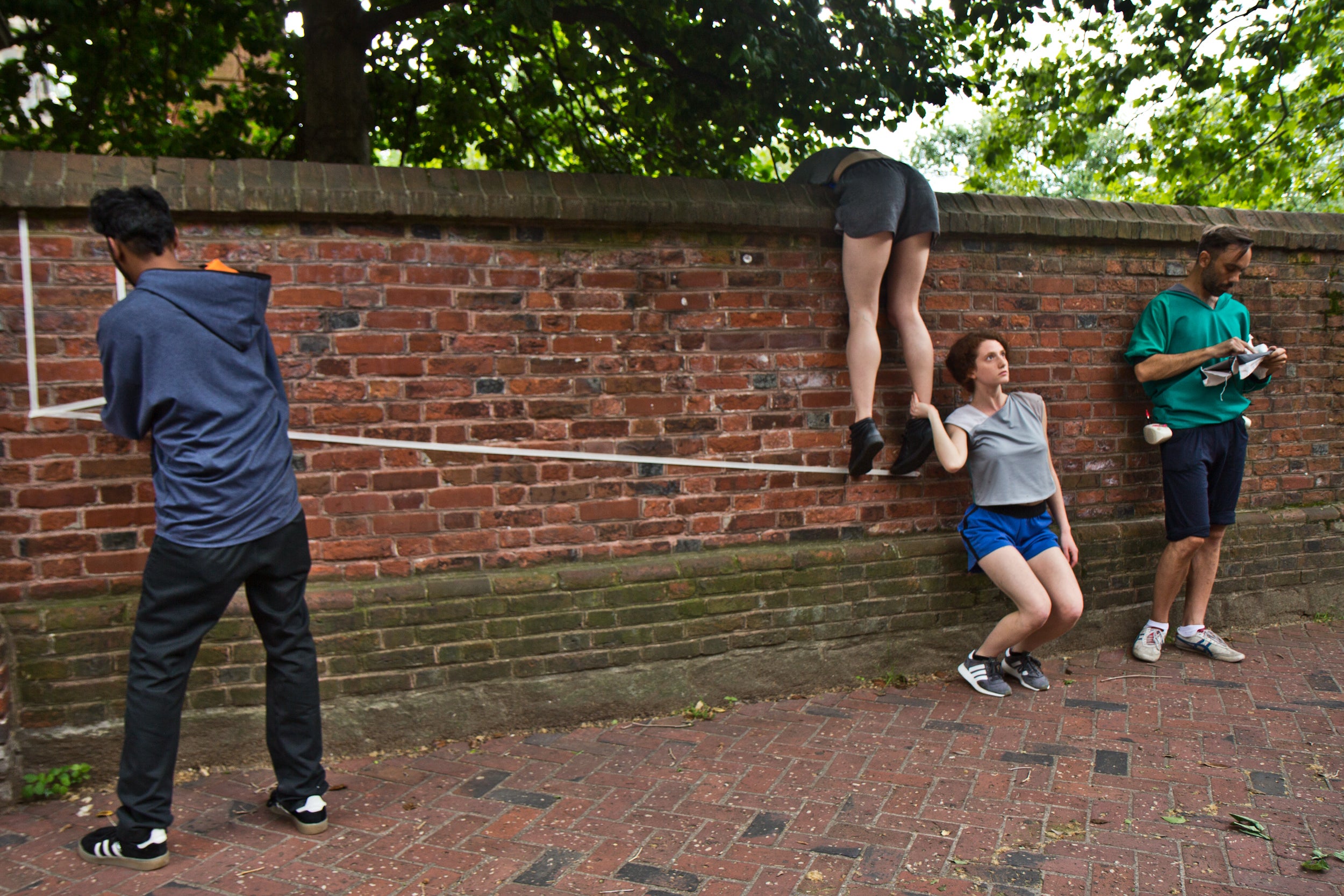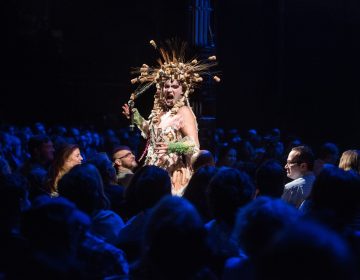‘Tape Riot’: A theater piece that plays off the city’s built environment
A group of European artists drop into town to reimagine the city’s built environment — using masking tape and modern dance — in the middle of an evening commute
Listen 2:44
Asphalt Piloten performs Tape Riot in Philadelphia as part of the Kimmel Center’s 2018 Philadelphia International Festival of the Arts. (Kimberly Paynter/WHYY)
This story originally appeared on PlanPhilly.
—
In “Tape Riot,” a piece of street theater being performed this week as part of the Philadelphia International Festival of the Arts (PIFA), a group of European artists drop into town to reimagine the city’s built environment — using masking tape and modern dance — in the middle of an evening commute.
The show is a walking performance. Audience members are told the secret location when they buy their tickets, and once there they follow two dancers, a mobile DJ, and a visual artist armed with a tote bag full of rolls of adhesive tape. The quartet walks a short route, interacting with various street elements that include brick walls, signposts, curbs, and painted lines on the asphalt. There is no narration, no characters or guide: The audience has to figure out for itself what’s going on.
“The idea was not to come here with a show and build a stage and put it outside,” said Anna Anderegg, choreographer and founder of the Switzerland-based group Asphalt Piloten. “The idea is: How can you do something that would work with the public space?”
The performance reacts to the environment in a structured improvisation, meaning the performers know they will stage actions in selected locations along a prescribed route, but the actual performance is largely invented on the spot in response to what, or who, is there at the time.
A few weeks ago, Anderegg was in Philadelphia for the first time to scout eight locations for Asphalt Piloten’s eight shows. Noting how walkable the city is, she was looking for the ideal mix of pedestrians, automobile traffic, and the occasional pocket of sparsely populated space.
“It can’t be too busy, and it can’t be too little crowded,” she said. “The golden middle, we are trying to look for.”
Asphalt Piloten’s first performance was on Tuesday night in Society Hill, where, at 5:30 p.m., the troupe encountered dogs on their evening walk, the occasional light traffic jam, kids playing in parks, and one angry bicyclist who shouted vulgarities as she was forced to swerve out of her lane for all the onlookers.
The music was provided by a DJ, who, using a handheld digital mixer and a pair of speakers on his belt, recorded the sounds around him and looped them into an electronic soundtrack of pulses and wooshes. A full playground of children at Three Bears Park, on Delancey Street, provided much of his material.
While improvised dance in public spaces may not be new, “Tape Riot” takes a unique spin by adding a tape artist. Herve Thiot used paper masking tape and black gaffer tape to draw lines on the ground and walls.
What the lines mean is open to interpretation: They could be vectors of movement, abstracted objects drawn in 3D perspective, implied boundaries, graffiti, etc. Thiot responded to the dancers, and the dancers to him.
Society Hill is a neighborhood of brick and cobblestone. Starting with the flagstones of Three Bears Park and moving to the brick sidewalks of Pine Street, Thiot played with the rigid grout lines. Most everything there is arranged in sharp grids of 90-degree angles — large swaths of squares and rectangles — that the lines of tape either accentuated or violated.
“The tape artist creates lines and a new perspective,” said Anderegg. “With a few lines, he can change the perspective of the space, and the sense of the space. It might get another meaning, create an illusion of utopia for a very short time.”
Sometimes, the dancers – dressed in geometrically patterned T-shirts and running shorts — would be “caught” in a taped box and then eventually break out.

Perhaps unintentionally, the taped patterns were sometimes reminiscent of the network of waterways that used to run between the Delaware and Schuylkill Rivers, long ago buried under Philadelphia’s urban build. It’s doubtful Thiot would be aware of the historic tributaries that once veined the landscape.
Perhaps more intentionally, the taped lines reminded viewers that the urban environment and concrete, brick, and asphalt – the hardscaped world inside of which we willfully exist – were once imagined like so many lines of tape.
It’s sometimes easy to assume, particularly in such a historic neighborhood as Society Hill, that the lines that contain our lives are absolute. Masking tape offered a malleable reimaging of space.
The coda of Tuesday’s performance took place in a cul-de-sac near Headhouse Square. The music became more aggressively percussive, and one of the dancers repeatedly banged herself against a three-story brick wall, while the tape artist drew a complex network of perspective boxes resembling a skyline.
A group of young boys playing basketball at the end of the cul-de-sac stopped to take in the dancers, the music, the tape, and the two-dozen onlookers who suddenly crowded their space. Parents opened front doors to see what the commotion was. The four boys watched, ball in hand, mesmerized.
After about five minutes, either perplexed or bored, they turned their backs on the finale and got back to their game.
—
“Tape Riot” runs through June 8. Information: https://www.kimmelcenter.org/events-and-tickets/201718/pifa/tape-riot
WHYY is your source for fact-based, in-depth journalism and information. As a nonprofit organization, we rely on financial support from readers like you. Please give today.





